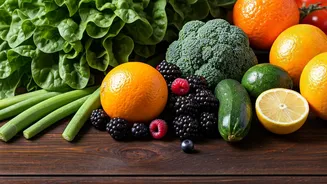Fiber-Rich Vegetables
Vegetables are a powerhouse for managing blood sugar because they're typically high in fiber and low on the glycemic index (GI). The GI measures how quickly
a food raises blood sugar levels. Fiber slows down the absorption of sugar, preventing rapid spikes and crashes. Non-starchy vegetables, such as leafy greens (spinach, kale), broccoli, cauliflower, and bell peppers, are excellent choices. They are loaded with vitamins, minerals, and antioxidants, providing numerous health benefits beyond blood sugar control. Fiber also promotes satiety, which helps prevent overeating and aids in weight management, a crucial factor in blood sugar regulation. Incorporating a variety of colorful, fiber-rich vegetables into your meals can significantly contribute to maintaining steady blood sugar levels and supporting overall health. Aim to fill half your plate with non-starchy vegetables at each meal to maximize these benefits.
Lean Protein Sources
Lean protein plays a key role in balancing blood sugar by slowing down the absorption of carbohydrates. This is achieved through the process of digestion, as protein takes longer to break down than carbohydrates, preventing a rapid surge in blood glucose. Good choices include chicken breast, turkey, fish (salmon, cod), and plant-based proteins like tofu, tempeh, and lentils. These protein sources not only help regulate blood sugar but also provide essential amino acids necessary for various bodily functions, including muscle repair and hormone production. Pairing protein with carbohydrates, such as vegetables or whole grains, is particularly effective in mitigating blood sugar spikes. Additionally, protein promotes satiety, helping to control appetite and prevent overeating, which supports weight management and further aids in blood sugar control. Include a serving of lean protein with each meal to experience these benefits.
Healthy Fats Overview
Healthy fats, particularly those found in sources like avocados, nuts, seeds, and olive oil, contribute to blood sugar stability by slowing down digestion and the absorption of glucose. These fats do not directly raise blood sugar levels and can help improve insulin sensitivity, the body’s ability to respond to the hormone insulin, which is critical for managing glucose. Monounsaturated and polyunsaturated fats are particularly beneficial. Avocado can be consumed in salads, as a side dish, or even in smoothies to enjoy its benefits. Nuts and seeds, such as almonds, walnuts, chia seeds, and flaxseeds, are easy to add to your diet as snacks or to sprinkle on meals. Olive oil can be used for cooking or as a dressing. Incorporating these healthy fats into your diet not only benefits blood sugar control but also provides essential nutrients and supports heart health. Moderation is key, but including a portion of these fats with each meal can aid in maintaining stable blood sugar levels.
Whole Grains Included
Whole grains provide a beneficial alternative to refined grains, supporting steady blood sugar levels due to their slower digestion and absorption rate. Unlike refined grains that rapidly convert into glucose, whole grains retain their fiber-rich bran and germ, which slows the release of sugar into the bloodstream. Excellent choices include quinoa, brown rice, oats, and whole-wheat bread. These grains offer a low to moderate glycemic index, meaning they don't cause significant blood sugar spikes. Furthermore, whole grains are rich in fiber, vitamins, and minerals. Fiber in whole grains helps to regulate digestion and promote feelings of fullness, which can assist in weight management and prevent overeating. Switching from refined grains to whole grains is a simple yet effective dietary change that can improve blood sugar control and overall health. When selecting bread, pasta, and other grain-based products, opt for those labeled “whole grain” and ensure the first ingredient listed is a whole grain.
Legumes' Importance
Legumes, including lentils, chickpeas, beans, and peas, are exceptional for blood sugar control due to their high fiber content and low glycemic index. Fiber slows down the digestion and absorption of carbohydrates, preventing sharp blood sugar increases. Legumes also provide a significant amount of protein, which further aids in blood sugar regulation. These foods release glucose into the bloodstream gradually, leading to more stable blood sugar levels. Moreover, legumes are packed with essential nutrients such as iron, folate, and potassium. They are relatively low in calories and have a significant impact on satiety, assisting with weight management. Regularly including legumes in your diet can help improve insulin sensitivity and reduce the risk of insulin resistance, a precursor to type 2 diabetes. Integrate legumes into your diet by adding them to soups, stews, salads, or enjoying them as a side dish for sustained health benefits.
Berries: Sweet Addition
Berries are an excellent choice for managing blood sugar due to their high fiber content and relatively low glycemic index, which help regulate blood sugar levels effectively. Fiber in berries slows the digestion and absorption of sugar, preventing sudden spikes. Berries like blueberries, strawberries, raspberries, and blackberries are rich in antioxidants and have anti-inflammatory properties, supporting overall health. Additionally, these fruits provide vitamins, minerals, and other beneficial compounds without causing rapid blood sugar elevations. Enjoying berries as a snack, adding them to breakfast cereals, or incorporating them into smoothies provides a satisfying treat while contributing to healthy blood sugar management. The natural sweetness of berries satisfies cravings for sweets, making them a healthier alternative to processed sugary snacks and desserts. Regular consumption of berries can significantly support your health and well-being.






